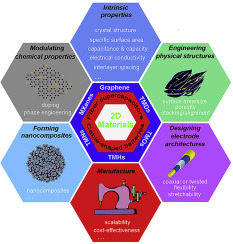Energy Storage Materials ( IF 18.9 ) Pub Date : 2019-02-23 , DOI: 10.1016/j.ensm.2019.02.020 Shengli Zhai , Li Wei , H. Enis Karahan , Xuncai Chen , Chaojun Wang , Xinshi Zhang , Junsheng Chen , Xin Wang , Yuan Chen

|
One-dimensional (1D) electrochemical energy storage devices, such as fiber supercapacitors and cable-shaped batteries, are promising energy storage solutions for emerging wearable electronics due to their advantages in flexibility, weavability, and wearability. Two-dimensional (2D) materials with unique structures and properties can be used to create novel 1D electrochemical energy storage devices. Here, we reviewed recent research efforts in using various 2D materials, such as graphene, transitional metal dichalcogenides, transition metal oxides, transition metal hydroxides, and transitional metal carbides and carbonitrides, to construct fiber supercapacitors and cable-shaped batteries. For every 2D material, we first examined its intrinsic properties and their impacts on its energy storage performance. Next, we reviewed several universal approaches which have been used to enhance its performance, including creating nanostructures, controlling the stacking/alignment, modulating chemical properties via doping or phase engineering, forming nanocomposites to increase electrical conductivity or stability, and designing fiber/cable electrode architectures. Further, we also compared the key characteristics and energy storage performance of recently reported 1D electrochemical energy storage devices containing 2D materials. Last, we offer our perspectives on the challenges and potential future research directions in this area. We hope this review can stimulate more research to realize the applications of 2D materials in practical 1D electrochemical energy storage devices.
中文翻译:

一维电化学储能设备的2D材料
一维(1D)电化学储能设备,例如光纤超级电容器和电缆形电池,由于它们在柔韧性,可编织性和可穿戴性方面的优势,是新兴的可穿戴电子设备有希望的储能解决方案。具有独特结构和特性的二维(2D)材料可用于创建新颖的一维电化学能量存储设备。在这里,我们回顾了最近在使用各种2D材料(例如石墨烯,过渡金属二卤化碳,过渡金属氧化物,过渡金属氢氧化物,过渡金属碳化物和碳氮化物)来构造纤维超级电容器和电缆状电池方面的研究成果。对于每种2D材料,我们首先检查其固有属性及其对能量存储性能的影响。下一个,我们审查了用于增强其性能的几种通用方法,包括创建纳米结构,控制堆叠/排列,通过掺杂或相工程调节化学性质,形成纳米复合材料以提高电导率或稳定性以及设计纤维/电缆电极体系结构。此外,我们还比较了最近报道的包含2D材料的1D电化学能量存储设备的关键特性和能量存储性能。最后,我们对这一领域的挑战和潜在的未来研究方向提出了自己的看法。我们希望这篇综述可以激发更多的研究,以实现2D材料在实际的1D电化学储能设备中的应用。控制堆叠/排列,通过掺杂或相工程调节化学性质,形成纳米复合材料以提高电导率或稳定性以及设计纤维/电缆电极体系结构。此外,我们还比较了最近报道的包含2D材料的1D电化学能量存储设备的关键特性和能量存储性能。最后,我们对这一领域的挑战和潜在的未来研究方向提出了自己的看法。我们希望这篇综述可以激发更多的研究,以实现2D材料在实际的1D电化学储能设备中的应用。控制堆叠/排列,通过掺杂或相工程调节化学性质,形成纳米复合材料以提高电导率或稳定性以及设计纤维/电缆电极体系结构。此外,我们还比较了最近报道的包含2D材料的1D电化学能量存储设备的关键特性和能量存储性能。最后,我们对这一领域的挑战和潜在的未来研究方向提出了自己的看法。我们希望这篇综述可以激发更多的研究,以实现2D材料在实际的1D电化学储能设备中的应用。和设计光纤/电缆电极架构。此外,我们还比较了最近报道的包含2D材料的1D电化学能量存储设备的关键特性和能量存储性能。最后,我们对这一领域的挑战和潜在的未来研究方向提出了自己的看法。我们希望这篇综述可以激发更多的研究,以实现2D材料在实际的1D电化学储能设备中的应用。和设计光纤/电缆电极架构。此外,我们还比较了最近报道的包含2D材料的1D电化学能量存储设备的关键特性和能量存储性能。最后,我们对这一领域的挑战和潜在的未来研究方向提出了自己的看法。我们希望这篇综述可以激发更多的研究,以实现2D材料在实际的1D电化学储能设备中的应用。
















































 京公网安备 11010802027423号
京公网安备 11010802027423号